Enhancing Deposit Exploitation Efficiency Utilizing Small-Diameter Radial Boreholes via Hydraulic Drilling Nozzles for Optimal Resource Recovery
Abstract
:1. Introduction
2. Development of the Radial Drilling Technology
3. Stages of Drilling a Radial Borehole
- Pulling out the production equipment: the first step is to retrieve the production equipment from the well, along with any existing downhole equipment.
- Cleaning the borehole: the borehole is then cleaned to prepare it for the subsequent drilling process.
- Determining the correct depth and orienting the deflector outlet: The correct depth is determined, and the deflector outlet is oriented using appropriate tools, such as a gyroscope. This operation can be performed after fastening the anchor.
- Casing: Casings are installed on the borehole. A radial borehole drilling set enables drilling a window in the casing for further drilling behind them and includes components such as a deflector, an anchor, and other elements (control section).
- Fastening the anchor: the anchor is securely fastened in place.
- Fastening the window cutting tool: a tool for making a window in the casing pipe is attached to the capillary.
- Making a window in the casing: using the window cutting tool, a window is created in the casing.
- Pulling out the tool: the window cutting tool is then removed from the well.
- Arming the capillary: The capillary is equipped with a flexible high-pressure elastic hose with a nozzle and is inserted into the deflector. Drilling is initiated to the specified length using the drilling set.
- Retracting the drilling set: the drilling set is retracted from the hole while simultaneously flushing the borehole to remove the drill cuttings.
- Pulling out the drilling set: The drilling set is completely removed from the well. The anchor is unhooked, and if necessary, the orientation of the deflector is changed for drilling another window and borehole.
- Completing the operation: the final step involves pulling out the entire downhole set and securing the production equipment back into the well.
4. Cavitation Jet Drilling
- —pressure of stagnation;
- —static pressure;
- ρ—liquid density;
- v—jet velocity.
- —build-up pressure produced by the cavitation flux;
- —saturation vapor pressure;
- α—parameter influencing the cavitation process (the gas content of the liquid, expressed as the ratio of the partial pressure of the gas to the stagnation pressure at the beginning of bubble destruction).
| Test Conditions, MPa | Jetting Velocity, cm/s | Width of the Crack, cm | Length of the Crack, cm | Stream Power, kW | Specific Energy per Unit of Crack Volume, J/cm2 | |
|---|---|---|---|---|---|---|
| Berea Sandstone | ATM * | 9.5 | 0.87 | 5.48 | 71.8 | 1390 |
| 3.45 | 9.45 | 2.30 | 3.18 | 71.8 | 2390 | |
| 6.90 | 9.45 | 1.67 | 2.95 | 71.8 | 2580 | |
| 13.80 | 9.45 | 1.27 | 3.02 | 71.8 | 2520 | |
| 20.70 | 9.45 | 1.43 | 1.91 | 71.8 | 3980 | |
| Indiana Limestone | ATM * | 9.45 | 1.43 | 0.40 | 71.8 | 19,000 |
| 3.45 | 9.45 | 1.59 | 0.33 | 71.8 | 23,000 | |
| 6.90 | 9.45 | 1.19 | 0.33 | 71.8 | 23,000 | |
| 20.70 | 9.45 | 1.19 | 0.41 | 71.8 | 16,200 |
5. Drilling Nozzles Using a Continuous High-Pressure Liquid Stream
6. Conclusions
- The jet exhibits high-velocity vortex motion in the bottom zone from the frontal outlet hole(s) of the nozzle. This motion allows for an erosive action, ensuring the contact of the jet with the rock surface.
- Backward outlet holes either allow for or assist the advance of the high-pressure flexible hose tool during hole propagation. Depending on their angle, they may also contribute to widening the excavated borehole.
- The swirling stream of fluid from the reverse openings not only aids in the advance of the flexible hose but also facilitates the cuttings transport to the main wellbore.
- The swirling motion of the outlet jet(s) can be optimized by changing the angle of the nozzle back holes, possibly spiraling through the housing wall and separating the front segment of the rotating nozzle.
- The ROP (Fp) is determined by the equation Fp = Fs (jet force) − Fd (pressure force acting on the nozzle face) − Ft (frictional force of the nozzle drill head, flexible hose, friction and bending of the elastic hose in the deflector knee). This force is limited by the increasing length of the hose with the head in the horizontal borehole. Equilibrium is reached when the frictional forces are equal to the jet force in the nozzle, defining the maximum end length of the borehole.
- The circumferential component forces of the vortex streams induce torsional moments from both the forward and the reverse vortex streams. Balancing these moments is critical to prevent excessive torsional stresses in the high-pressure flexible hose that could lead to buckling and vibration of the whole system. The angles and diameters of the front and rear nozzle outlets, as well as the potential bearing of the front of the rotating nozzle, affect the balance of these moments.
- The introduction of an internal arrangement of inclined vanes, discs, or rotors to achieve a rotating fluid stream in the nozzle also affects the torsional stresses in both the flexible high-pressure hose and the nozzle, and this must be taken into account.
- Optimal distance between the backward outlets and the facetool of the nozzle is crucial to maintain pressure balance in the rotary drilling nozzle.
- When introducing a new solution that combines elements from known solutions, new functions or improvements to existing activities/functions should be meticulously identified. In addition, consideration should be given to reducing or enhancing the disadvantages associated with the new solution.
- Hydraulic pressure: 70 MPa.
- Jet speed: 300 m/s.
- Distance of the nozzle outlet holes from the excavated rock sample.
- Efficiency of adding an abrasive mass.
- Type of abrasive material.
- Shape of the abrasive grains.
- Size and hardness of the abrasive materials.
- Length and diameter of the nozzle.
- Diameter of the nozzle outlet hole.
- Rate of penetration, calculated as the difference between the force of the streams directed toward the back of the nozzle and that of liquid streams flowing out of the face of the nozzle.
Author Contributions
Funding
Conflicts of Interest
References
- Cinelli, S.D.; Kamel, A.H. Novel Technique to Drill Horizontal Laterals Revitalizes Aging Field. In Proceedings of the SPE/IADC Drilling Conference, Amsterdam, The Netherlands, 5–7 March 2013. [Google Scholar] [CrossRef]
- Jeffryes, B.P. Schlumberger Oilfield Research, Novel Drilling Techniques, Chapter 9.5. In Advanced Drilling and Well Technology; SPE: Willis, TX, USA, 2009. [Google Scholar]
- Dickinson Ben, W.O.; Dickinson, R.W. Horizontal Radial Drilling System. In Proceedings of the SPE California Regional Meeting, Bakersfield, CA, USA, 27–29 March 1985. [Google Scholar] [CrossRef]
- Toma, P.; Reitman, V.; Coffin, P.; Dickinson, W. Long and Ultrashort Turning Radius of Horizontal Wells Predictions of Future Production Based on Today’s Experience. In Proceedings of the 13th World Petroleum Congress, Buenos Aires, Argentina, 20–25 October 1991. [Google Scholar]
- Dongjun, M.A.; Li, G.; Huang, Z.; Niu, J.; Hou, C.; Liu, M.; Li, J. A Model of Calculating the Circulating Pressure Loss in Coiled Tubing Ultrashort Radius Radial Drilling. Pet. Explor. Dev. 2012, 39, 528–533. [Google Scholar] [CrossRef]
- Yonghe, L.; Chunjie, W.; Lianhai, S.; Weiyi, G. Application and Development of Drilling and Completion of the Ultrashort-radius Radial Well by High Pressure Jet Flow Techniques. In Proceedings of the SPE International Oil and Gas Conference and Exhibition in China, Beijing, China, 7–10 November 2000. [Google Scholar]
- Yan, C.; Ren, X.; Cheng, Y.; Deng, F.; Zhang, J.; Li, Q. An Experimental Study on the Hydraulic Fracturing of Radial Horizontal Wells. Geomech. Eng. 2019, 17, 535–541. [Google Scholar] [CrossRef]
- Dickinson Ben, W.O.; Anderson, R.R.; Dickinson, R.W. The Ultrashort-Radius Radial System. SPE Drill. Eng. 1989, 4, 247–254. [Google Scholar] [CrossRef]
- Salem Ragab, A.M. Improving well Productivity in an Egyptian Oil Feld Using Radial Drilling Technique. J. Pet. Gas Eng. 2013, 4, 103–117. [Google Scholar] [CrossRef]
- Abdel-Ghany, M.A.; Siso, S.; Hassan, M.A.; Pastura, P.; Cherri, R. New Technology Application, Radial Drilling Petrobel, First Well In Egypt. In Proceedings of the 10th Offshore Mediterranean Conference and Exhibition, Ravenna, Italy, 23–25 March 2011. [Google Scholar]
- Kamel, A.H. A Cost Effective Frackless Solution for Production Enhancement in Marginal Fields. In Proceedings of the SPE Eastern Regional Meeting, Canton, OH, USA, 13–15 September 2016. [Google Scholar] [CrossRef]
- Huang, Z.; Huang, Z.; Wu, L.; Su, Y.; Hong, C. Trajectory Measurement of Radial Jet Drilling Wells: Improved Tool and Data Processing. J. Energy Resour. Technol. 2020, 142, 032902. [Google Scholar] [CrossRef]
- Dickinson Ben, W.O.; Dykstra, H.; Nees, J.M.; Dickinson, E. The Ultrashort Radius Radial System Applied to Thermal Recovery of Heavy Oil. In Proceedings of the SPE Western Regional Meeting, Bakersfield, CA, USA, 30 March–1 April 1992. [Google Scholar] [CrossRef]
- Retalic, I.; Laird, A.; MacLeod, A.; Senergy, L.E.A. Coiled-Tubing Drilling, Chapter 9.4. In Advanced Drilling and Well Technology; SPE: Willis, TX, USA, 2009. [Google Scholar]
- Wiśniowski, R. Wybrane Aspekty Projektowania Konstrukcji Otworów Kierunkowych z Wykorzystaniem Technik Numerycznych; Uczelnianie Wydawnictwa Naukowo Dydaktyczne AGH: Kraków, Poland, 2002. [Google Scholar]
- Wiśniowski, R.; Stryczek, S. Wybrane Aspekty Projektowania Trajektorii Osi Otworów Kierunkowych Wierconych z Podziemnych Wyrobisk Górniczych, Zeszyty Naukowe Politechniki Śląskiej, Seria Górnictwo z.279, Nr kol. 1764, Gliwice. 2007. Available online: https://delibra.bg.polsl.pl/Content/74362/BCPS-83468_2007_Wybrane-aspekty-proj.pdf (accessed on 8 January 2024).
- Wiśniowski, R.; Teper, W.; Zwierzyński, A.J.; Złotkowski, A.; Toczek, P. Sposób Powierzchniowego Odmetanowania Formacji Geologicznej Zawierającej Złoże Węgla Kamiennego, Akademia Górniczo—Hutnicza w Krakowie, Opis zgłoszeniowy wynalazku PL 436375 A1, Opubl. 2022-06-20, Zgłosz. nr P.436375 z dn. 2020-12-17, Biuletyn Urzędu Patentowego, ISSN 0137-8015, nr 25, s. 15, Kraków. 2022. Available online: http://patenty.bg.agh.edu.pl/pelneteksty/PL436375A1.pdf (accessed on 8 January 2024).
- Maurer, W.C. Advanced Drilling Techniques; Petroleum Publishing Co.: Tulsa, OK, USA, 1980. [Google Scholar]
- Wiśniowski, R.; Knez, D.; Hytroś, Ł. Drillability and Mechanical Specific Energy Analysis on the Example of Drilling in The Pomeranian Basin. AGH Drill. Oil Gas 2015, 32, 201–209. [Google Scholar] [CrossRef]
- Toczek, P.; Wisniowski, R.; Stryczek, S.; Ziaja, J.; Mazur, C. Total Specific Energy (TSE) as a New Indicator of Drilling Efficiency. AGH Drill. Oil Gas 2017, 34, 715–729. Available online: https://journals.bg.agh.edu.pl/DRILLING/2017.34.3/drill.2017.34.3.715.pdf (accessed on 8 January 2024).
- Kamel, A.H. Radial Jet Drilling: A Technical Review. In Proceedings of the SPE Middle East Oil & Gas Show and Conference, Manama, Bahrain, 6–9 March 2017. [Google Scholar] [CrossRef]
- Gang, B.; Gensheng, L.; Zhonghou, S.; Huang, Z.; Dongjun, M.; Liangbin, D. Experimental Research on the Technology of Hydra-Jet Sidetracking of Radial Micro-borehole. J. Eng. Sci. Technol. Rev. 2013, 6, 137–142. [Google Scholar] [CrossRef]
- Conn, A.F.; Rudy, S.L. Parameters for a Ship Hull Cleaning System Using the Cavitating Water Jet Method; National Technical Information Service, TR-7510-1 Final Rpt.; Maritime Administration: Washington, DC, USA, 1975.
- Johnson, V.E. Process for Drilling by a Cavitating Fluid Jet. U.S. Patent 3528704, 15 September 1970. [Google Scholar]
- Conn, A.F.; Rudy, S.L. Cutting Coal with The Cavijet Cavitating Water Jet Method. In Proceedings of the 3rd International Symposium Jet Cutting Technology, Chicago, IL, USA, 11–13 May 1976. [Google Scholar]
- Conn, A.F.; Radtke, R.P. CAVIJET Augmented Deep-Hole Drilling Bits. J. Pressure Vessel Technol. 1978, 100, 52–59. [Google Scholar] [CrossRef]
- Lichtarowicz, A. Experiments with Cavitating Jets. In Proceedings of the 2nd International Symposium on Jet Cutting Technology; British Hydromechanics Research Association: Cambridge, UK, 1974. [Google Scholar]
- Minghui, W.; Chenghuai, W.; Yanxi, Z. Numerical Simulation and Experimental Study on Flow of Polymer Aqueos Solution in Porous Jet Nozzle. Adv. Polym. Technol. 2020, 2020, 7580460. [Google Scholar] [CrossRef]
- Landers, C. Method of and Apparatus for Horizontal Drilling. U.S. Patent 6125949A, 3 October 2000. [Google Scholar]
- McLeod, R.D.; Dwight, N.L. Lateral Jet Drilling System. U.S. Patent 6189629B1, 20 February 2001. [Google Scholar]
- Peters, J.N. Method and Apparatus for Lateral Well Drilling Utilizing an Abrasive Fluid Stream Discharged from Rotating Nozzle. U.S. Patent 0173544A1, 9 July 2009. [Google Scholar]
- Chi, H.; Li, G.; Huang, Z.; Tian, S.; Song, X. Maximum Drillable Length of the Radial Horizontal Micro—Hole Drilled with Multiple High-Pressure Water Jets. J. Nat. Gas Sci. Eng. 2013, 26, 1042–1049. [Google Scholar] [CrossRef]
- Summers, D.A. Water Jet Cutting Related to Jet and Rock Properties. In Proceedings of the 14th U.S. Symposium on Rock Mechanics (USRMS), University Park, PA, USA, 11–14 June 1972. [Google Scholar]
- Labus, T.J. Energy Requirements of Rock Penetration by Water Jets. In Proceedings of the 3rd International Symposium on Jet Cutting Technology, Paper No. E3, Chicago, IL, USA, 11–13 May 1976. [Google Scholar]
- Labus, T.J. Cutting and Drilling of Composites Using High Pressure Water Jets. In Proceedings of the Fourth International Symposium on Jet Cutting Technology, Canterbury, UK, 12–14 April 1978. [Google Scholar]
- Labus, T.J. High-Pressure Water Jet Applications in Drilling Operations, In High-Pressure Science and Technology; Timmerhaus, K.D., Barber, M.S., Eds.; Springer: Boston, Ma, USA, 1979. [Google Scholar] [CrossRef]
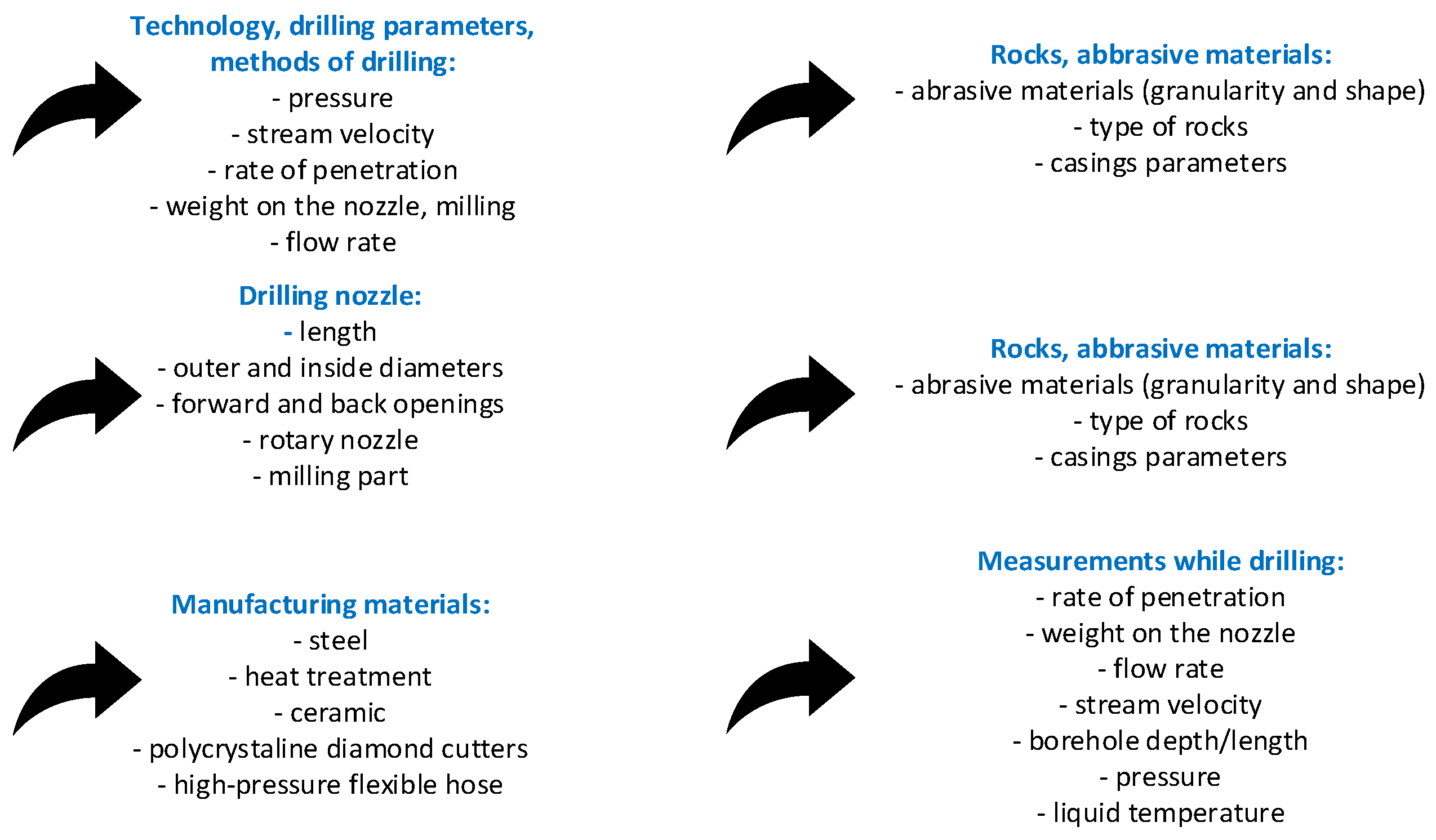

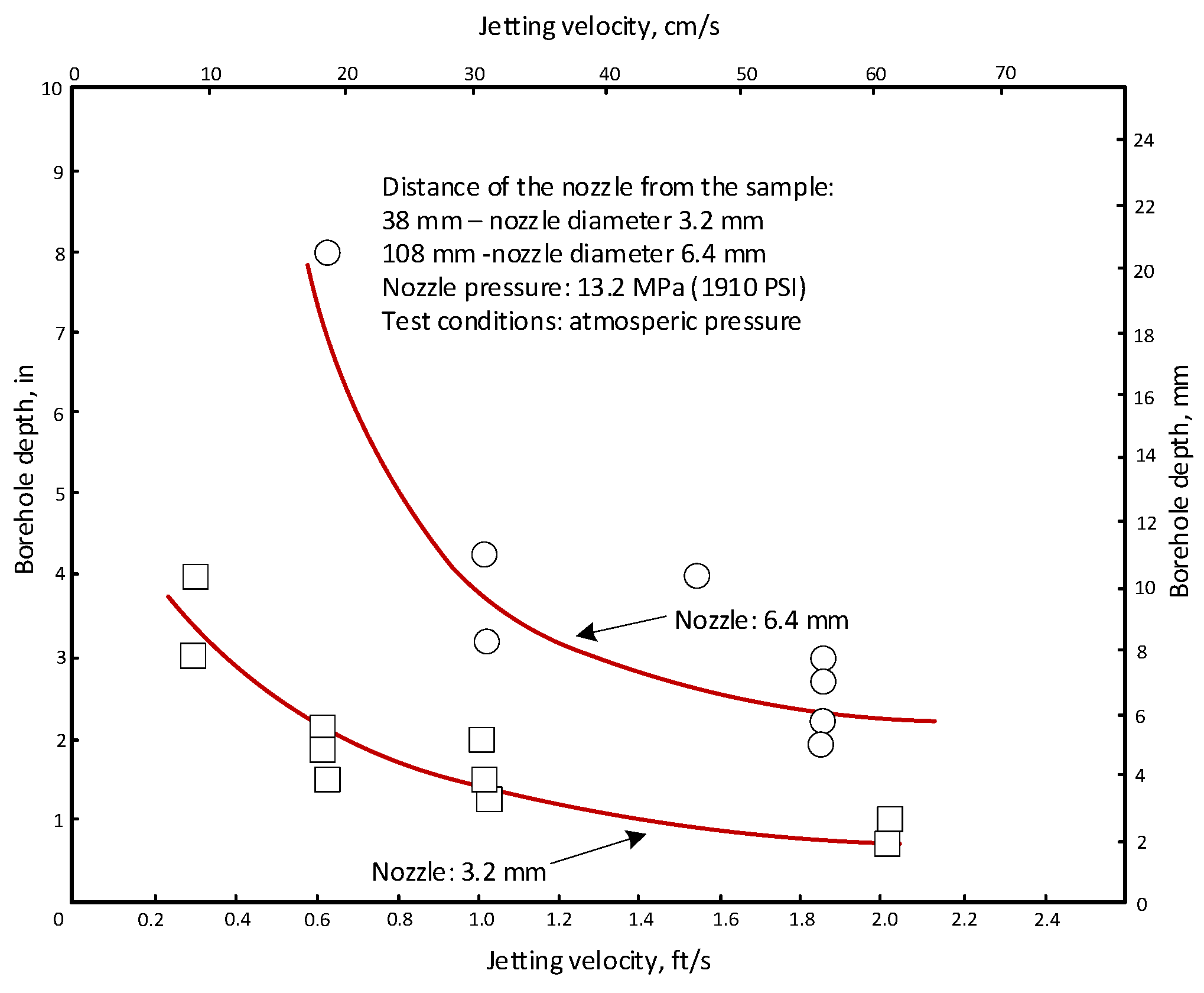
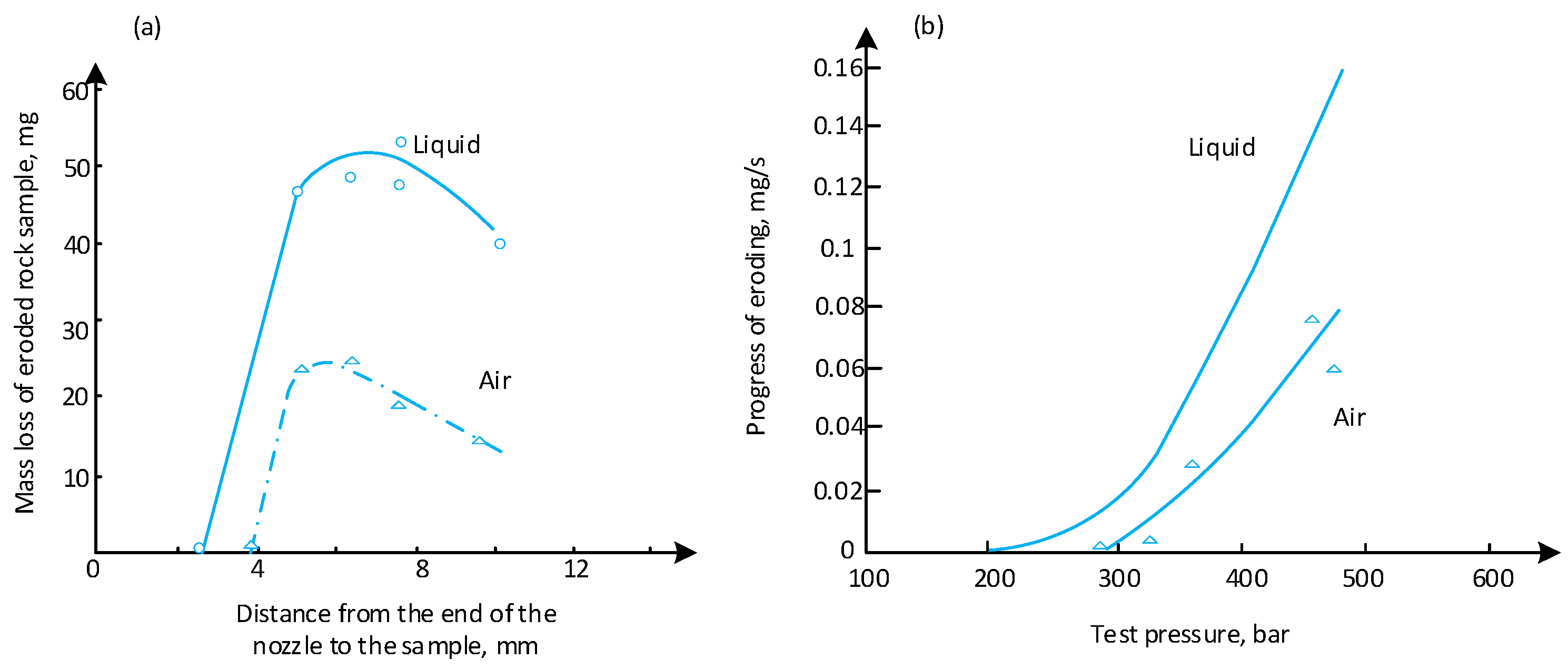
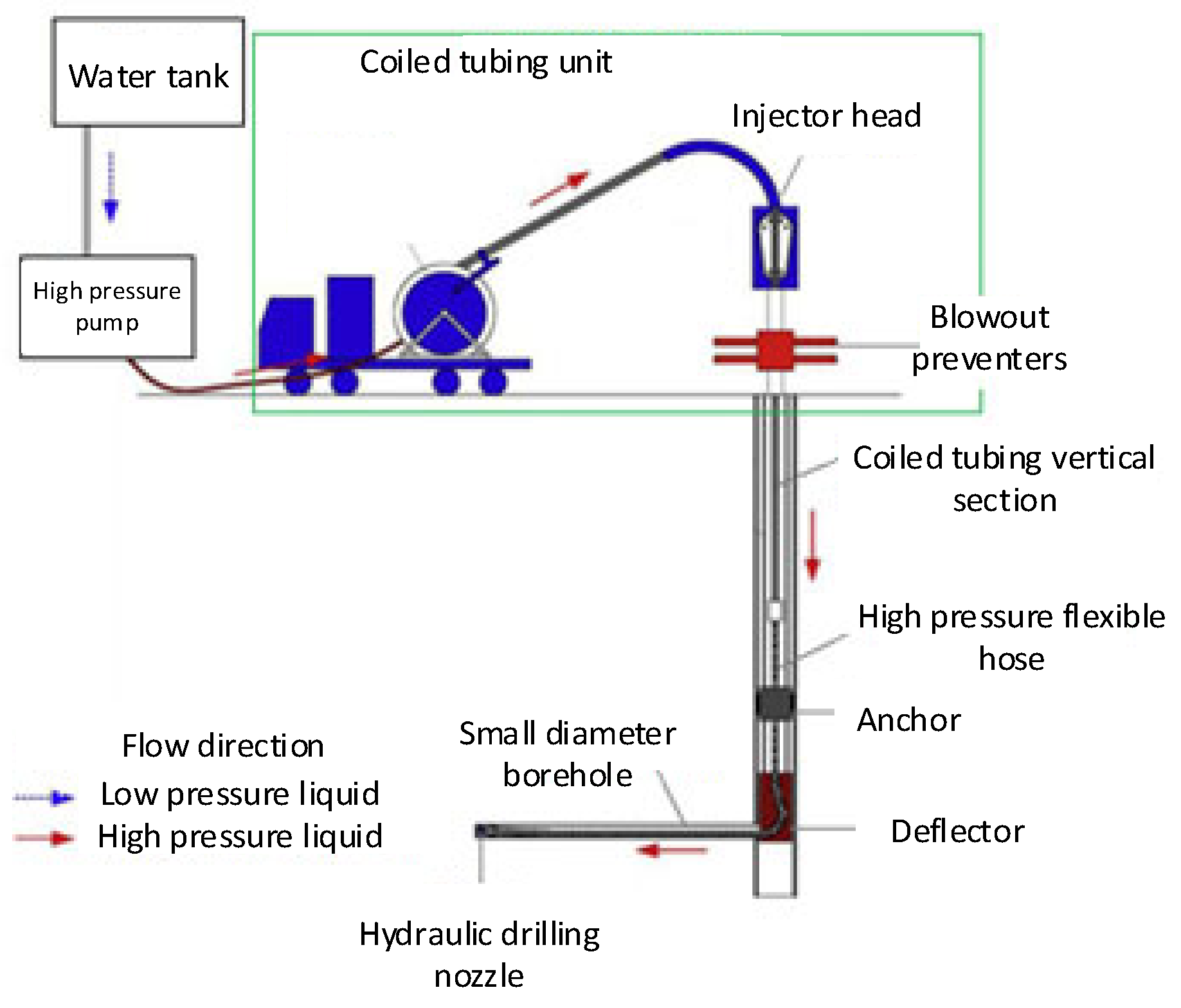
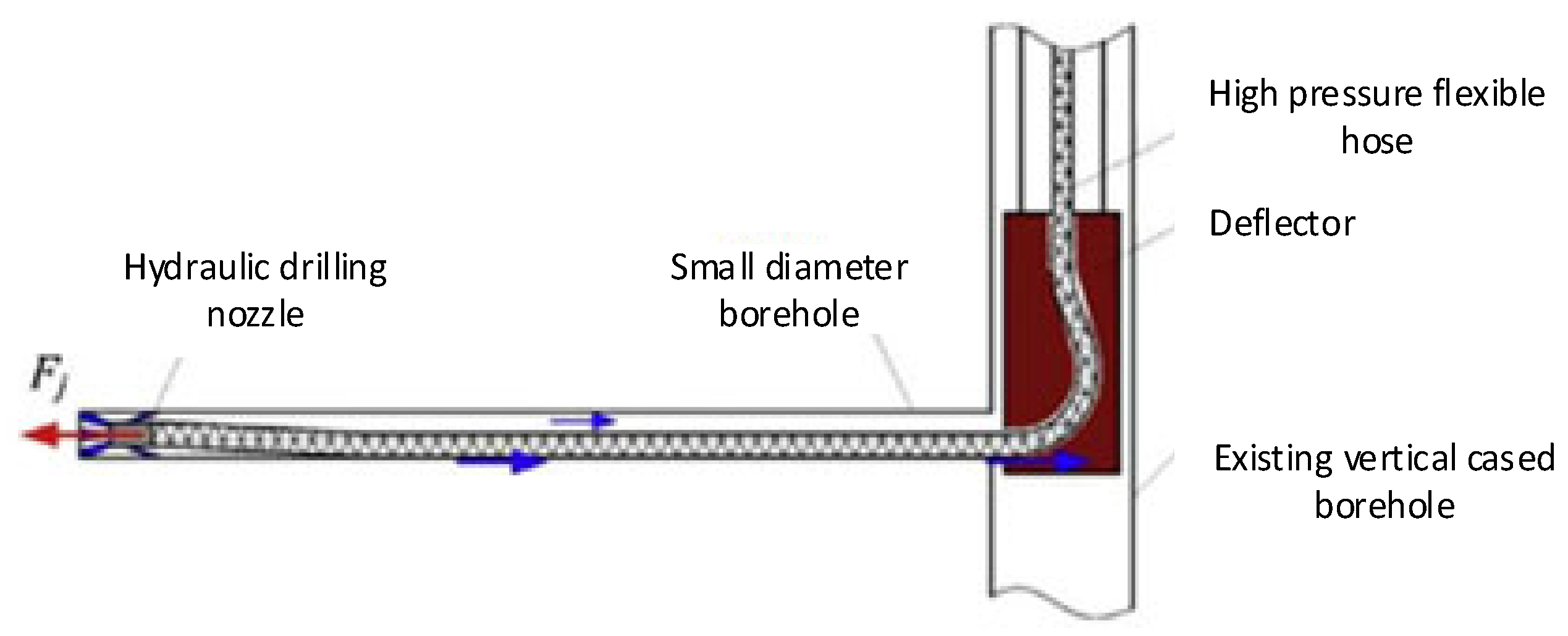


| Stream Pressure, MPa | Jetting Velocity, m/s | Average Crack Depth, cm | Average Crack Width, cm | Stream Power, kW | Specific Energy of Jet Drilling, J/cm3 | Specific Energy of Jet Drilling per Unit of Crack Volume, J/cm2 |
|---|---|---|---|---|---|---|
| 1000–1100 | 10.1 | 4.20 | 0.31 | 307 | 6630 | 7240 |
| 900–1000 | 10.1 | 4.12 | 0.31 | 259 | 5570 | 6220 |
| 800–900 | 10.1 | 4.60 | 0.31 | 230 | 4420 | 4950 |
| 700–800 | 10.1 | 3.75 | 0.31 | 190 | 5240 | 5020 |
| 600–700 | 10.1 | 3.64 | 0.31 | 138 | 6040 | 3750 |
| 500–600 | 10.1 | 3.91 | 0.31 | 117 | 7100 | 2960 |
| 400–500 | 10.1 | 3.30 | 0.31 | 76 | 4910 | 2280 |
| 300–400 | 10.1 | 3.32 | 0.31 | 56 | 5220 | 1670 |
| 200–300 | 10.1 | 2.68 | 0.31 | 38 | 2760 | 1400 |
| 100–200 | 10.1 | 1.67 | 0.31 | 14 | 2620 | 830 |
| 0–100 | 10.1 | 1.11 | 0.31 | 5 | 1490 | 445 |
| Stream Pressure, MPa | Jetting Velocity, m/s | Average Crack Depth, cm | Average Crack Width, cm | Stream Power, kW | Specific Energy of Jet Drilling, J/cm3 | Specific Energy of Jet Drilling per Unit of Crack Volume, J/cm2 |
|---|---|---|---|---|---|---|
| 1000–1100 | 40.64 | 4.28 | 0.20 | 289 | 5160 | 1660 |
| 900–1000 | No data available | |||||
| 800–900 | 40.64 | 4.76 | 0.20 | 223 | 4000 | 1150 |
| 700–800 | 40.64 | 3.33 | 0.20 | 164 | 3740 | 1210 |
| 600–700 | 40.64 | 3.60 | 0.20 | 140 | 3470 | 960 |
| 500–600 | 40.64 | 2.96 | 0.20 | 106 | 3960 | 880 |
| 400–500 | 40.64 | 2.75 | 0.20 | 83 | 3750 | 740 |
| 300–400 | 40.64 | 2.97 | 0.20 | 57 | 1900 | 470 |
| 200–300 | 40.64 | 2.69 | 0.20 | 33 | 1370 | 300 |
| 100–200 | No data available | |||||
| 0–100 | No data available | |||||
Disclaimer/Publisher’s Note: The statements, opinions and data contained in all publications are solely those of the individual author(s) and contributor(s) and not of MDPI and/or the editor(s). MDPI and/or the editor(s) disclaim responsibility for any injury to people or property resulting from any ideas, methods, instructions or products referred to in the content. |
© 2024 by the authors. Licensee MDPI, Basel, Switzerland. This article is an open access article distributed under the terms and conditions of the Creative Commons Attribution (CC BY) license (https://creativecommons.org/licenses/by/4.0/).
Share and Cite
Toczek, P.; Wisniowski, R. Enhancing Deposit Exploitation Efficiency Utilizing Small-Diameter Radial Boreholes via Hydraulic Drilling Nozzles for Optimal Resource Recovery. Appl. Sci. 2024, 14, 3552. https://doi.org/10.3390/app14093552
Toczek P, Wisniowski R. Enhancing Deposit Exploitation Efficiency Utilizing Small-Diameter Radial Boreholes via Hydraulic Drilling Nozzles for Optimal Resource Recovery. Applied Sciences. 2024; 14(9):3552. https://doi.org/10.3390/app14093552
Chicago/Turabian StyleToczek, Przemyslaw, and Rafal Wisniowski. 2024. "Enhancing Deposit Exploitation Efficiency Utilizing Small-Diameter Radial Boreholes via Hydraulic Drilling Nozzles for Optimal Resource Recovery" Applied Sciences 14, no. 9: 3552. https://doi.org/10.3390/app14093552





